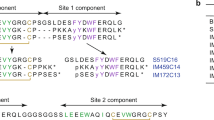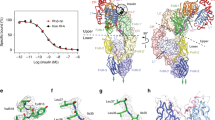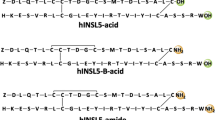Abstract
Seven regions of the α subunit of human insulin receptor (HIR) were synthesized and examined for their ability to bind radioiodinated insulin. A peptide representing one of these regions (namely, residues α655–670) exhibited a specific binding activity for insulin. In quantitative radiometric titrations, the binding curves of125I-labeled insulin to adsorbents of peptide α655–670 and of purified placental membrane were similar or superimposable. The binding of radioiodinated insulin to peptide or to membrane adsorbents was completely inhibited by unlabeled insulin, and the inhibition curves indicated that the peptide and the membrane on the adsorbents had similar affinities. Synthetic peptides that were shorter (peptide α661–670) or longer (peptide α651–670) than the region α655–670 exhibited lower insulin-binding activity. It was concluded that an insulin-binding region in the HIR α subunit resides within residues α655–670. The results do not rule out the possibility that other regions of the α subunit may also participate in binding of HIR to insulin, with the region described here forming a “face” within a larger binding site.
Similar content being viewed by others
References
Ebina, Y., Ellis, L., Jarnagin, K., Edery, M., Graf, L., Clauser, E., Ou, J.-H., Masiarz, F., Kan, Y. W., Goldfine, I. D., Roth, R. A., and Rutter, W. J. (1985).Cell 40, 747–758.
Fujita-Yamaguchi, Y., Choi, S., Sakamoto, Y., and Itakura, K. (1983).J. Biol. Chem. 258, 5045–5049.
Hunter, W. M., and Greenwood, F. C. (1962).Nature (London)194, 495–496.
Jacobs, S., Haxum, E., Schnechter, Y., and Cuatrecasas, P. (1979).Proc. Natl. Acad. Sci. USA 76, 4918–1912.
Kasuga, M., Karlsson, F. A., and Kahn, C. R. (1972).Science 215, 185–187.
Koketsu, J., and Atassi, M. Z. (1973).Biochim. Biophys. Acta 328, 289–302.
Koketsu, J., and Atassi, M. Z. (1974a).Immunochemistry 11, 1–8.
Koketsu, J., and Atassi, M. Z. (1974b).Biochim. Biophys. Acta 342, 21–29.
Massague, J., Pilch, P. F., and Czech, M. P. (1980).Proc. Natl. Acad. Sci. USA 77, 7137–7141.
Massague, J., Pilch, P. F., and Czech, M. P. (1981).J. Biol. Chem. 256, 3182–3190.
McCormick, D. J., and Atassi, M. Z. (1984).Biochem. J. 224, 995–1000.
Mulac-Jericevic, B., and Atassi, M. Z. (1987a).J. Protein Chemistry 6, 365–373.
Mulac-Jericevic, B., and Atassi, M. Z. (1987b).Biochem. J. 248, 847–852.
Mulac-Jericevic, B., and Atassi, M. Z. (1988).J. Protein Chemistry 7, 173–177.
Pilch, P. F., and Czech, M. P. (1979).J. Biol. Chem. 253, 3375–3381.
Roth, R. A., Morgan, D. O., Beaudoin, J., and Sara, V. (1986).J. Biol. Chem. 261, 3753–3757.
Sakata, S., Kobayashi, M., Miura, K., and Atassi, M. Z. (1988).Immunol. Invest. 17, 237–242.
Siegel, T., Ganguly, S., Jacobs, S., Rosen, O. M., and Rubin, C. S. (1981).J. Biol. Chem. 256, 9266–9273.
Twining, S., and Atassi, M. Z. (1979).J. Immunol. Methods 30, 139–151.
Ullrich, A., Bell, J. R., Chen, E. Y., Herrera, R., Petruzzelli, L. M., Dull, T. J., Gray, A., Coussens, L., Liao, Y.-C., Tsubokawa, M., Masson, A., Seeburg, P. H., Grunfeld, C., Rosen, O. M., and Ramachandran, J. (1985).Nature 313, 756–761.
Yip, C. C., Yeung, C. W., and Moule, M. C. (1978).J. Biol. Chem. 253, 1743–1745.
Author information
Authors and Affiliations
Rights and permissions
About this article
Cite this article
Nakamura, S., Sakata, S. & Atassi, M.Z. Localization and synthesis of an insulin-binding region on human insulin receptor. J Protein Chem 9, 229–233 (1990). https://doi.org/10.1007/BF01025313
Received:
Published:
Issue Date:
DOI: https://doi.org/10.1007/BF01025313




